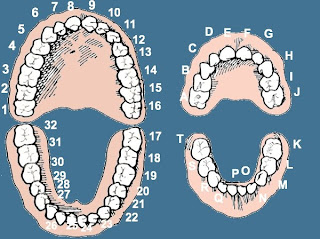

Mystery #2 – Lingual, that’s like your tongue, right? Take a look at the photo below for a representation of what I’m talking about. When you hear us talking about baby teeth we reference letters instead of numbers (A through E). Therefore when you hear us say “the bracket is off on the lower right 6” that means that the lower right first molar (6 th tooth from the front) needs a new bracket. Your front tooth is number 1 and the very back tooth (your wisdom tooth) is number 8. We number these teeth by quadrants (upper right, upper left, lower right, lower left – or UR, UL, LL, LR).
#TEETH NUMBERS USA FULL#
A person with a full set of teeth (including wisdom teeth) has 32 teeth. When we talk about your teeth we have a specific way to signal to each other what tooth we are talking about. Don’t judge me for using the word “y’all.” It is impossible to live in the south for four years, marry a southerner, and not incorporate it into your daily vernacular. Because we want the blog to be informative and educational I’d like to take this chance to give y’all a crash course in what we are saying. Contact Dr.So at some point in almost every patient’s treatment, we get some comment about the weird language that we use when talking to our clinical assistants. Kao’s practice in Downtown Los Angeles accommodates patients with diverse individual needs. He restores dental health and function with exceptional care and compassion. Kao is a dental specialist in Periodontics and Dental Implants in Los Angeles. Only capital letters from A-T are used in naming the primary teeth.ĭr. The lower arch is named in a similar way, in reverse alphabetical order from T-K. The numbering of primary (baby) teeth begins with the upper arch, A-J, and includes both quadrants. Teeth number from 1-32 sequentially starting in quadrant 1 and ending with quadrant 4. The image above is of the Universal numbering system for permanent (adult) teeth. The major advantage is it follows a sequential pattern is easy to understand. It has one drawback: there are no names for supernumerary (extra) teeth. In the Universal numbering system, primary and permanent teeth are named differently.

Radiographs are the x-rays dentists use in their clinical practice. Clinical dentistry is “the study and treatment of conditions within the oral cavity. This system is accepted and approved by the American Dental Association (ADA). In the United States, dentists use the Universal tooth numbering system. Globally, there are several systems to do this. Teeth Names & Numberingĭentists have to identify, communicate, and record information about individual teeth. This is to remove buildup between the teeth and gums. If your number is five or higher, a deep cleaning is necessary. They will check to see if your gums bleed easily. If you have a 4, your dentist may warn you about your risk for periodontal disease and bone loss. You have been brushing, flossing, and using antibacterial mouthwash on a regular basis. If you hear your dentist say a number between one and three, your gums are healthy. Kao specializes in the prevention, diagnosis, and treatment of periodontal disease, and the precise placement of dental implants. Larger gaps are signs of gum disease, plaque, and tartar buildup.ĭr. It is preferable to have smaller gaps between your teeth and your gums. So the lower the number, the smaller the gap. These numbers are described in millimeters. The number assigned to the gums describes how deep the gaps are between your teeth and your gums. Unlike quadrant numbers, gum numbering is not for dividing parts of the mouth. As you go clockwise around your mouth, the numbers get higher. From the dentist’s perspective, quadrant 1 is on the top left. It’s helpful to think of the numbers as they are on a clock. Notice that while the numbers go right to left on top and left to right on the bottom. Parts of the Mouthĭentists divide the mouth into four areas, or quadrants. Some numbers signify area, while others signify the condition of your oral health. Knowing your teeth names helps you understand your diagnosis and treatment.ĭentists assign numbers to your mouth for various reasons. When you understand what your dental team is saying, you feel more confident as a patient.

Learning this vocabulary, including teeth names, can help you communicate with your dentist better. Trying to understand what a dentist says can be a dizzying experience.


 0 kommentar(er)
0 kommentar(er)
